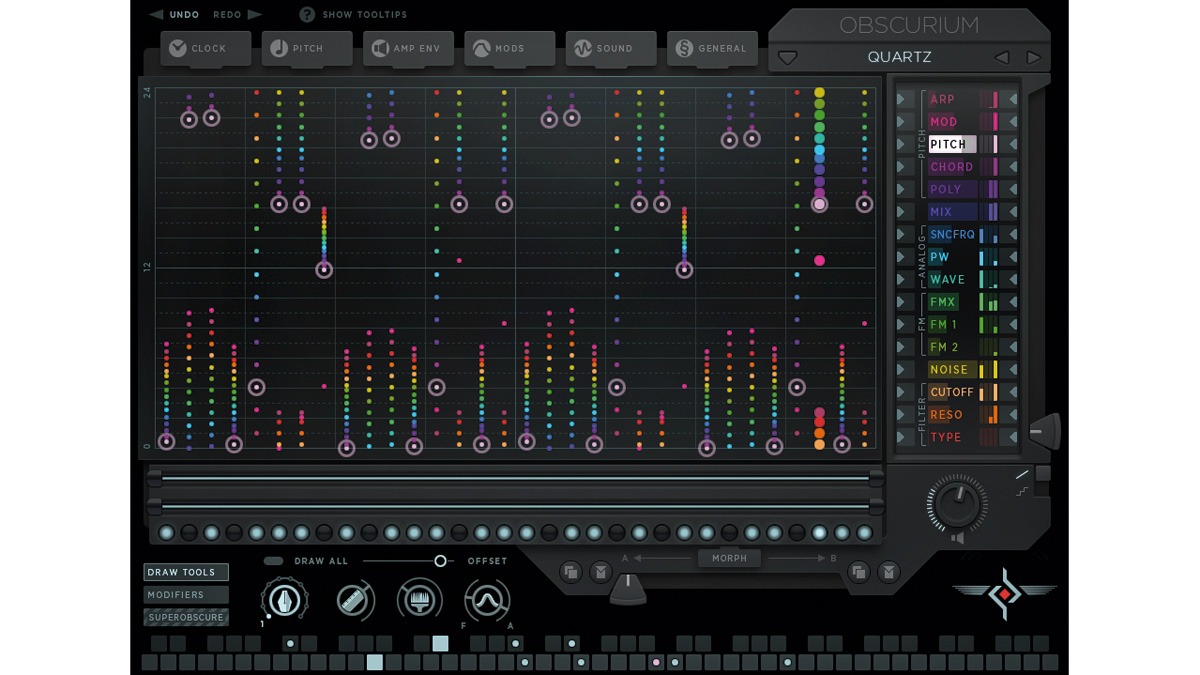MusicRadar Verdict
Obscurium is an amazing synth in its own right, but it becomes essential when you start getting other instruments involved.
Pros
- +
Great sound. Highly versatile. Immensely inspirational. VST instrument hosting. Huge preset selection.
Cons
- -
Grey on black text can be difficult to read at times.
MusicRadar's got your back
Describing Obscurium (VST/AU/RTAS/AAX/standalone) in a single sentence isn't easy, but 'hybrid virtual analogue and FM synth with 16-lane modulation sequencer, chord generator sequencer and arpeggiator' is close enough.
With the press of a single key, Obscurium can create massively complex evolving riffs and patterns. You can also disable the pitch functions and play it like a regular MIDI synth, but its real value is undoubtedly as a source of track-starting ideas.
Obscurium's two sound generators are deceptively basic-looking. The first is an analogue-style oscillator with three modulatable parameters (Sync Frequency, Pulse Width and Waveshape) and a Spread control for shifting between sync saw/pulse waves suitable for bass and lead noises, and a super-saw mode for thick pads and strings.
The second is an FM oscillator with three operators and three routing algorithms, plus three further sound-altering controls available via modulation. The generators sound impressive but could be considered mere starting points, as both the standalone and plugin versions of Obscurium can host VST instruments.
"With the press of a single key, Obscurium can create massively complex evolving riffs and patterns."
Arguably, Obscurium's defining feature is its 'generative pitch engine', a powerful system via which complex arpeggios, chords and stacked voices are generated by choosing one of 34 Scales and/or four Chord Tables that define notes/groups of notes for selection and triggering by the synth's two sequencers.
The first of these sequencers is the Trigger Sequencer - the row of white dots towards the bottom of the interface. This is activated by incoming MIDI notes, triggering the adjustable three-stage Arp Envelope for each note generated by the pitch engine, as well as the Mod Envelope.
The Arp Envelope can be progressively mixed with the regular MIDI- triggered ASR Amp Envelope, too, so you could, for example, have a held note play a pad and generate a percussive pattern at the same time.
You got the Motion
The second sequencer is the 32-step Motion Sequencer, which takes up the majority of the interface and is used to modulate 16 specific instrument parameters - Filter cutoff, Pulse Width, number of active voices, active Chord, etc.
The first five lanes relate to the Pitch engine: Arp, Mod, Pitch, Chord and Poly. Then there are three lanes each for the analogue and FM generators, and another three for the multimode filter (high-, low- or bandpass). The remaining two lanes control a Noise generator and the analogue/FM Mix.
"Obscurium features a brilliantly intuitive editing system for adjusting multiple steps together."
The modulation sequence for each parameter is represented by a series of colour- coded dots, all of which are visible all the time for all parameters, but with draggable handles around those of the selected one.
These sequences can be further modulated in real time, and the result is limitless potential for creating riffs, noises, basslines, percussion, atmospheres, pads, chord sequences... you name it. The scope is mind-boggling, and we heard at least 50 potential track-starting sequences among the presets alone.
The sheer number of multi-coloured dots in the Motion Sequencer might be intimidating, but Obscurium features a brilliantly intuitive editing system for adjusting multiple steps together.
The four Draw Tools are Grid (enabling up to 32 steps to be adjusted up and down together), Ruler (for drawing ramps), Brush (a randomiser with 'depth' control) and Sine (for drawing sine wave shapes of definable frequency and amplitude). These tools can be applied to individual lanes or all of them at once, with an Offset control ensuring variation between lanes.
The other two editing toolsets - Modifiers and Superobscure - facilitate quick shuffling of existing settings (cutting and pasting, swapping, exchanging values with the step to the left or right, etc) and user-definable random step value creation, respectively.
There's also a modulatable Morph Fader, the main function of which is smoothly transitioning between two complete Motion Sequencer setups. And below the Trigger Sequencer lie two independent Loop Faders for independently setting the start and end points of the Motion and Trigger sequences.
Parameter Shift progressively switches the Motion lane parameter assignments (swapping the Chord and Cutoff sequences, for example) and can be modulated.
Then there's Obscure Clock, which uses an eight-step sequencer to adjust the speed of the Motion Sequencer; and Obscure Sequencer, which uses another eight- step sequencer to do weird and wonderful things to the playback order of the Motion Sequencer steps. The more you play with Obscurium, the more you discover.
Despite its apparent complexity, using Obscurium quickly becomes second nature. We can't think of a synth that makes it easier or quicker to create complex, unique patches, and as the selection of over 400 presets demonstrates, it's surprisingly versatile. It also sounds great, offering warmth, punch, bite, edge and smoothness in equal measure - and then there's the ability to incorporate third-party instruments, which obviously extends the shelf- life immensely.
If you make any kind of electronic music, are involved in sound design or produce music for visual media or games, you owe it to yourself to try this remarkable instrument.
Computer Music magazine is the world’s best selling publication dedicated solely to making great music with your Mac or PC computer. Each issue it brings its lucky readers the best in cutting-edge tutorials, need-to-know, expert software reviews and even all the tools you actually need to make great music today, courtesy of our legendary CM Plugin Suite.

Will Smith reveals the advice Jay-Z and Kendrick Lamar gave to him before his music comeback

“I’ve often wondered if it was the Devil grinning up at me, or God smiling down on me. I still haven’t figured out who had the final say”: How a feat of spontaneous creativity resulted in one of Pink Floyd’s most majestic moments

“It's transparent when not in operation, crisp when looping, and handles high-gain and complex audio sources with ease”: TC Electronic Ditto 2 Looper review










